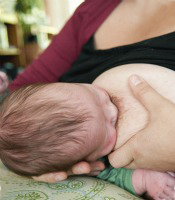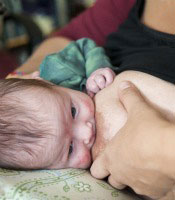
Latch
Effective latch
Effective latch-on is a learned skill. Your baby is not born hungry. It's OK if your baby doesn't latch on right away.
To get an effective latch:
- Support your breast.
- Support the base of your breast well behind the areola with your thumb on one side and your fingers on the opposite side.
- Rotate your hand until your thumb is across from your baby's nose. Leave enough space so your thumb and fingers don't get in your baby's way.
- Place your baby's head and body facing your body (nose to nipple).
- You can use a finger or your nipple to stroke your baby's cheek so their face turns toward you. (This is the rooting reflex.)
- Encourage your baby to open their mouth wide (like a yawn).
- When your baby’s mouth is near the nipple, tickle under your baby’s nose to upper lip with your nipple. That will make your baby open their mouth. Allow your baby’s head to tilt back so they look up at you. This will help your baby open their mouth as wide as possible.
- If your breast is very firm, it may be hard for your baby to come deeply onto the breast. In that case, you can hand express a little milk ("soften" the areola). Expressing some colostrum on your nipple may encourage your baby to take the nipple and begin to suck.
- Make sure your nipple is pointing to the roof of your baby's mouth.
- When your baby’s mouth is near the nipple, tickle under your baby’s nose to upper lip with your nipple. That will make your baby open their mouth. Allow your baby’s head to tilt back so they look up at you. This will help your baby open their mouth as wide as possible.
- Bring your baby quickly and gently onto your breast.
- Your baby's tongue should be between your breast and their lower gum.
- Your baby's bottom lip should be farther away from the nipple than the top lip. (See photos.)
- Your baby's chin and cheeks should be against your breast with their nose close to your breast. Your baby's lips are pushed outward, like fish lips. This is more likely to happen when they open their mouth wide before they take hold of the breast.
With an effective latch, your baby will make bursts of rhythmic sucking. You should hear swallowing. Your baby will suck rapidly until the milk lets down.
When your baby comes off your breast, the nipple should look longer and be evenly rounded.
Try to burp your baby.
If your baby begins to nurse and then falls asleep in fewer than 10 minutes, continue nursing with the same breast. Take your baby off the breast, burp them, and then try to waken them by talking to them, rubbing their back or feet, or taking off some of their clothes. Then offer your baby your breast again.
When you start to breastfeed, you may feel some gentle tugging discomfort during the initial latching on. Tenderness the first week is normal.
Call your lactation resource if:
- you feel discomfort after 10 days
- any time you have more intense pain or your nipples are cracked, bruised or start to bleed
- you have questions or other concerns
Crying is a late sign of hunger. It is best to start a feeding before your baby gets worked up and is crying hard. It can be more difficult to get an upset baby to latch well.
Ineffective latch
Signs of an ineffective latch are:
- discomfort or pain that does not improve during feeding
- dimpling (drawing in) of cheeks
- clicking sounds
- baby comes off breast and your nipple is flattened or creased
Break the seal and re-latch. It is important to break the suction before you try to remove your baby from your breast. Slide your finger into the corner of your baby's mouth to break the suction.
All photos © Allina Health System

Support your breast and place your baby's head and body facing your body (nose to nipple). |

After your baby opens their mouth wide, quickly and gently bring your baby onto your breast. |

Your baby needs to be close to your breast. If you are worried about your baby being able to breathe easily, reposition your baby a little. |
Related resources